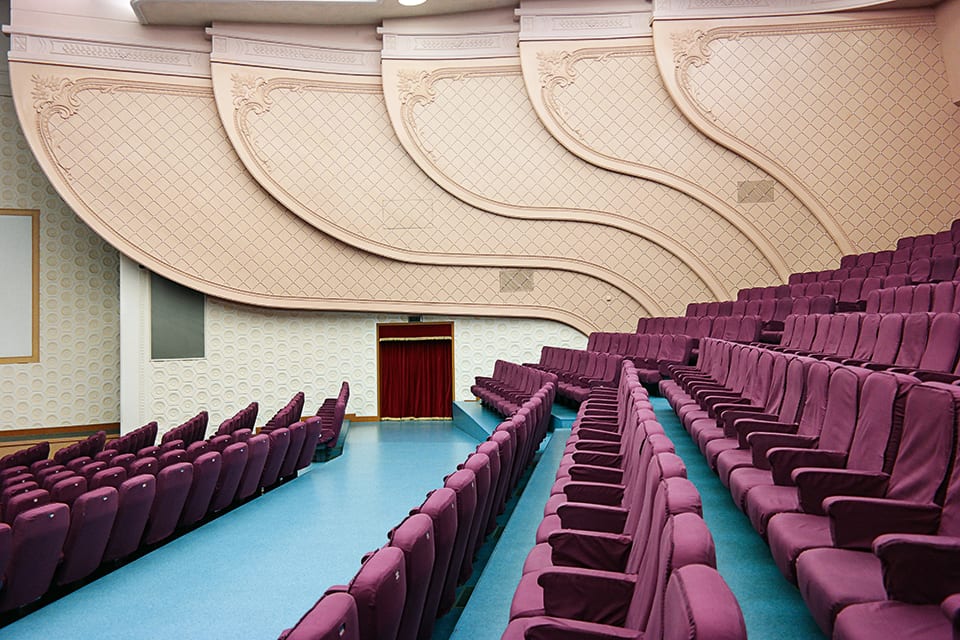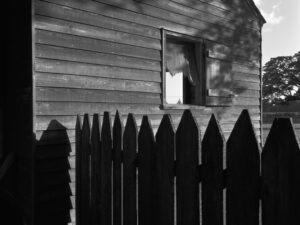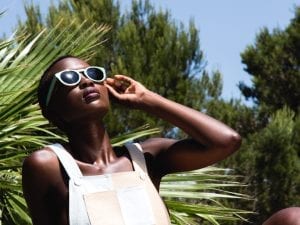Photographs of the country’s interior and exterior structures provide thought-provoking insights into a society built upon fairyland aesthetics.
Kim Jong-un, the North Korean leader, once declared: “Let us turn the whole country into a socialist fairyland.” Guardian architecture critic Oliver Wainwright gained access to the country in July 2015, and has just published a new photography book, Inside North Korea, with Taschen. He read about that quotation whilst in the insular “hermit kingdom”, and has since created a compelling publication, which began with an online blog posting images from the trip. “At first it sounds like meaningless propaganda,” he tells Aesthetica. “But I realised there might be something genuine behind it. The interiors and aesthetics of the new buildings did have this childlike, fantastical, kindergarten look to them. It made me think it could be part of a state-sponsored ideology – a way of infantilising the populous. It seemed to be a kind of sugar-coated architectural tranquilliser.”
Photography has a strange and singular ability to reflect the world as it is and, simultaneously, communicate our attempts at pretence and illusion. There’s a simple yet startling image, one that acts potentially as both an instant adjoiner to Kim Jong-un’s hopes for such a fairytale land, and to many of the western clichés of a totally impoverished and automated North Korean life. In the style of the Hong Kong-based German architecture photographer Michael Wolf, Wainwright documented in careful geometric unity the windows and balconies of a Pyongyang residential block. Through the windows, we get a peek into roughly 60 apartments, and therefore a tiny insight into hundreds of lives.
One observation is immediate. Houseplants are a big deal in Pyongyang, as they are in London. Terracotta pots are placed on many of the balconies. Through the glass windows, we can see flowers and plants evident in the living spaces of Kim Jong-un’s residents. Some balconies overflow with plants, flowers cascading over the lip of the balcony. Other flats demonstrate a precise orientation of plants in relationship to each other. Others have just a single pot, whilst others are completely empty of any floral life. The images suggest that some residents take great pride and invest deeply in such humble plants, and in how they look to the outside world. Other residents have different aesthetic considerations.
It speaks, one might think, of keeping up appearances, of a community living broadly compatible lives – a collective which, whilst in many ways similar, also exists within small gradations of difference. It brings to mind the quotation from the North Korean defector Lee Hyeon-seo, now an activist living in South Korea: “North Korea is not the dictator’s country; it’s the 25 million citizens’ and they are suffering under the dictator.” That same dissident, of course, has other things to say of the country of her birth: “In communism, we never had any freedom – of movement, of speech, of press. We didn’t even make own decisions for our lives, our future. We were human robots,” she once stated.
Other details in the image raise questions. A small number of flats have solar panels on their balconies – a sign of a wealth discrepancy, or a social hierarchy. Only one apartment’s family dries their washing in public view. Whilst a couple of antennae poke from the roof, in what looks like a carefully designed – and therefore officially sanctioned – architectural decision, there are no satellite dishes randomly attached to many of the flats, as you would see across the west. Each flat is painted in a uniform mint green, which, whilst striking to behold, also points to the sense of the collective that defines so much of life in this isolated country.
In North Korea, the concept of “Juche” holds tremendous sway. Juche (pronounced ju-chay) is the national state ideology of self-reliance – “a kind of Marxism–Leninism with a hint of Confucianism” – developed by Kim Il-sung. Pyongyang was almost entirely razed to the ground by the American bombing campaign during the Korean War and was rebuilt from scratch from 1953 onwards. This rebuilding project was conceived by the country’s founding father, the Eternal President Kim Il-sung, as “a great garden of Juche architecture.”
The dictator said: “Juche means that all the problems of the revolution and of building construction must be solved independently, and mostly without outside help according to the country’s abilities.” As Wainwright describes, the flowers in the homes of these Pyongyang citizens hold a deeply nationalistic significance, which adheres to Juche. Are we looking at small statements of individuality, or small expressions of patriotism, of floral devotions to their Great Leader?
Wainwright notes: “Even when their statues or portraits are not visible, the presence of the leaders is ensured throughout the city in the form of their two namesake flowers, the Kimilsungia and Kimjongilia.” The former is a violet orchid, which was first presented to Kim Il-sung in 1965 by Indonesia’s founding president, Sukarno; the latter is a bright scarlet begonia, first given as a gift by a Japanese botanist in 1988.
These floral signifiers are found all over Pyongyang, spilling from the balconies of patriotic citizens, adorning gigantic billboards at the top of apartment towers and emblazoned on roadside hoardings. Grown on a vast scale in army-run breeding centres, the flowers are brought out by the thousands of pots for national events, their longevity ensured by a chemical agent developed after years of research, according to the Korea Central News Agency (KCNA), which lengthens the blooming period by a week in summer and by 20 days in winter. The state mouthpiece often runs stories about selfless citizens who kept their flowers warm throughout the winter during the disastrous years of famine.
It’s almost impossible to imagine what it must be like to be raised in a country in which urban planning is adhered to with a near-religious sense of fervency, and in which a studied deference to the decisions made by the state is an unquestioned part of day-to-day life. Wainwright’s photographs help us on that journey – and make us realise a few things too: primarily, that Pyongyang is actually a beautiful city – spacious, pastoral and full of flair. “Isolated from outside influence for so long, and therefore free from the usual urban pressures of commercial speculation and inward migration, Pyongyang is one of the few places in the world where the original intentions remain intact,” Wainwright states. “The location is still governed and shaped by the same ideology it was first built to revere. Visiting the principal sites is therefore less like discovering the historic artefacts of a post-Soviet city than like time-travelling to a realm where the system is still in full force – where the founding fathers are very much present.”
Architecture, interiors and the formation of space within a built environment, we realise, are all key aspects of how Kim Jong-un and his dynasty have been able to exact such total control, obedience and devotion from a populous of roughly 26 million people. It is through these means that they project their sense of power and national aspirations to the country’s people and the world at large. The very way in which Pyongyang has been designed and built, says Wainwright, is “a precisely choreographed world where an idealised image of power and order is played out.”
Wainwright travelled with Koryo Tours, a Beijing-based company that has been taking groups of foreigners into North Korea since 1993. Wainwright met its founder, the UK-born Nick Bonner, at the Venice Architecture Biennale in 2014, where he had curated an exhibition of paintings by architects, imagining what the future of tourism might look like in their isolated country, and making Pyongyang appear like a city straight out of a science fiction film. Speaking to Aesthetica, Wainwright says: “They were like scenes from Thunderbirds. Bonner told me that these scenes weren’t too far from what they were actually building in Pyongyang now.”
Much has been written of cultural identity’s profound links to architectural space. For example, in Living in a hybrid world, published in Design and Society by the Design Council (1984), the author notes: “The proper and most useful definition of cultural identity will arise out of a fuller understanding of the creative processes of cultural interaction, not out of some kind of pre-selection of the supposedly ‘purer’ elements of regional culture. It is extremely doubtful that any culture still exists which has not, at one time or another, been exposed to ‘alien’ genes and culture forms. But what has emerged, when we look at specific historical regions such as Malaysia, is not some mere substitution of local culture forms for imported forms, but a new and original product.”
North Korea is one of the few hermetic cultures left in the developed world – one where very few “alien genes and cultural forms” have impeded. Indeed, to pay homage to other ideologies is to sign one’s own death certificate. Yet the country, on civic, unofficial and secretive levels, is beginning to open up to the outside world via a fledgling capitalistic economy, operated by the rising class of “donju”, or “masters of money” – also known as “red capitalists” – who operate black market enterprises that are tacitly tolerated.
“Donju invest in construction projects, establish partnerships with struggling state-owned factories and bankroll imports from China to supply retailers in the country’s growing number of markets – from which the state is also profiting,” Wainwright explains. According to Lee Byung-ho, a former director of South Korea’s intelligence service, at least 40 percent of the North Korean population is now engaged in some form of private enterprise. In March 2017, in an effort to collect more tax, the authorities reportedly ordered people selling goods from their homes to move into formal marketplaces. Wainwright reports that a cell-phone service launched in 2008 now has more than three million subscribers, whilst imported solar panels have become a middle-class status symbol. Apartments are no longer just assigned by working group, but traded on the black market, creating an appetite for domestic goods and aspirational furnishings, fuelled by the desire to ape the modern interiors of homes they have seen on South Korean TV shows, illicitly shared on USB sticks.
North Korea seems poised on the edge of change – particularly in light of Kim Jong-un’s recent summit with President Trump, and his meeting on the border with South Korean President Moon Jae-in. It’s possible that the images, which Wainwright captured in his camera in 2015, will be remembered as the urban landscape at its isolationist peak.
Tom Seymour
Inside North Korea is published by TASCHEN. www.taschen.com










